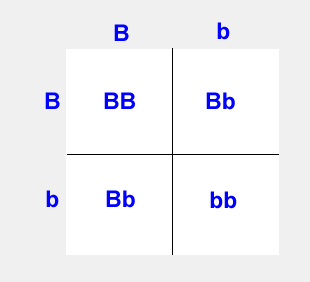How can recessive traits skip generations?
1 Answer
Recessive traits can skip generations because a dominant phenotype can be produced by either a homozygous dominant genotype or a heterozygous genotype. So two heterozygous individuals would have the dominant phenotype for a trait, but since they each have a recessive allele, they both could pass a recessive allele to an offspring, producing a homozygous recessive offspring with the recessive phenotype. This would be a monohybrid cross.
Example:
In mice, black coat color is dominant, and white is recessive. The black allele is represented by the letter B, and the white allele is represented by the letter b.
Two black mice that are heterozygous (Bb) for the black phenotype produce offspring. The following Punnett square represents the possibilities for their offspring.

As you can see, there is a 1 in 4 (25%) chance that they will have a homozygous recessive (bb) offspring with the white phenotype.
So both of the heterozygous (Bb) parents have the dominant black coat color, but the next generation, their offspring, could have the homozygous recessive genotype (bb), producing the recessive white coat color.
This is how a recessive trait can skip generations.

